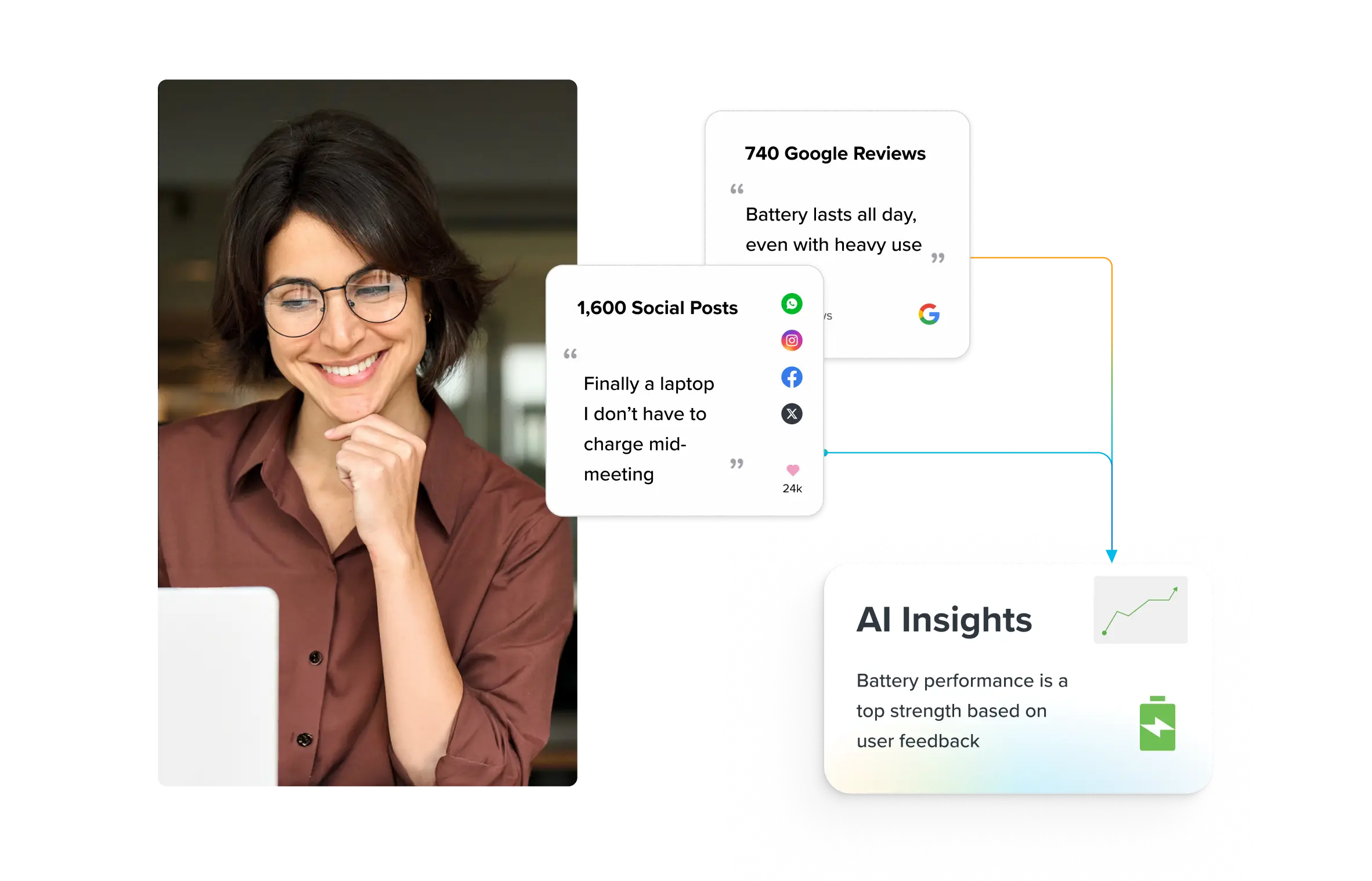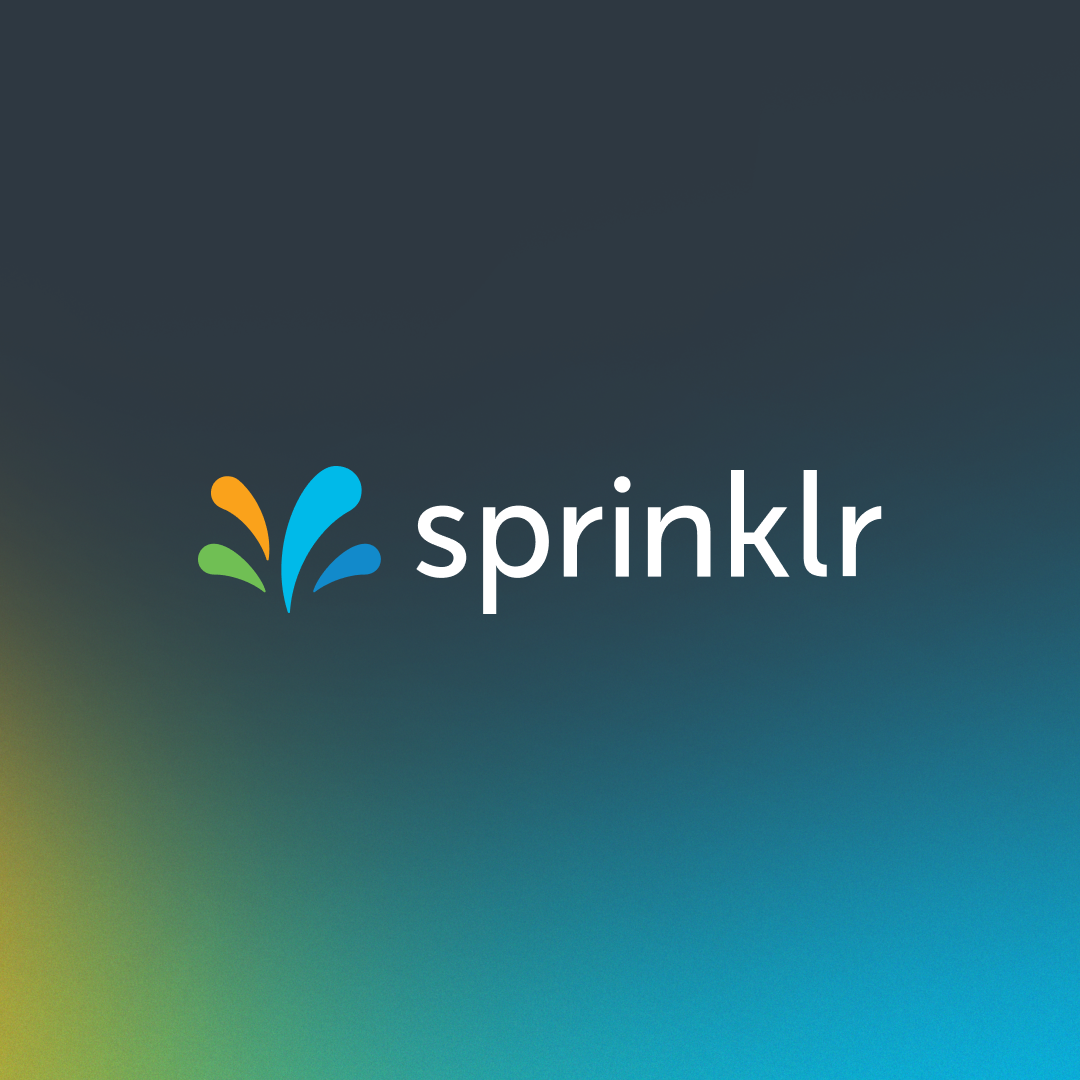Elevate CX with unified, enterprise-grade listening
Sprinklr Insights gives you real-time consumer, competitor and market intelligence from 30+ channels without the noise. Make smarter decisions, strengthen your brand, and stay relentlessly customer-led.

10 Types of Customer Feedback: The Right Way to Classify Them
Ken Blanchard, co-author of The One Minute Manager, once said, “Feedback is the breakfast of champions.” Yet, many companies treat it like an occasional snack — consuming it when convenient and ignoring it when it’s most needed. But today, customer feedback is as critical as your core business strategy. Without it, you risk making decisions based on assumptions rather than real customer insights.
To stay relevant, you must go beyond just collecting feedback. You need to track, analyze and act on it effectively. Understanding the different types of customer feedback allows you to pinpoint what’s working, what’s broken and where you can elevate the customer experience.
However, if you simply categorize feedback as positive, negative or neutral, you might overlook critical insights driving innovation, growth and customer satisfaction. And with the explosion of digital touchpoints, feedback now pours in from multiple channels — making it nearly impossible to manage if your teams operate in silos.
In this blog, we’ll explore the essential types of customer feedback you should track in 2025 and expert-backed strategies for managing them effectively.
What is customer feedback?
Customer feedback consists of insights, opinions and experiences customers share about a company's products, services or overall interactions with the brand. Customer-first enterprises actively gather and analyze feedback to identify what's working, what needs improvement and where strategic adjustments are required. This continuous feedback loop helps enhance customer experience, drive innovation and maintain a competitive edge in an evolving market.
Types of customer feedback (with examples)
For enterprises, collecting feedback is only the first step — the real challenge lies in categorizing and analyzing it effectively. Let’s break down the key types of customer feedback enterprises should track.
A. Based on the collection method
1. Direct feedback: What customers explicitly tell you
Direct feedback comes straight from customers through structured channels like surveys, customer support interactions and direct communication. This type of feedback is highly intentional and provides clear insights into what customers think, need and expect. CSAT survey, explained below is the most common among all.
- Customer satisfaction (CSAT) surveys
Customer satisfaction surveys measure customer satisfaction with a specific interaction, product or service. Unlike net promoter score (NPS), which assesses overall brand loyalty, CSAT focuses on individual touchpoints, such as an interaction, a purchase, a service request or the launch of a new feature, making it ideal for capturing immediate feedback. Timely feedback ensures accuracy and relevance, leading to more actionable insights.
2. Indirect feedback: What customers express without being asked
Not all feedback comes through customer surveys or direct conversations. Customers share their thoughts in ways you might not immediately recognize — through reviews, social media or even their behavior. Sifting through these indirect signals can uncover hidden opportunities for improvement.
- Customer reviews and in-app ratings
Online reviews are the digital equivalent of word-of-mouth. Whether on Google Reviews, Trustpilot, or the App Store, public opinions serve as valuable feedback and social proof. A single positive review can boost credibility, while negative feedback — if left unaddressed — can damage trust.
How to handle indirect customer feedback in 3-steps Reviews influence purchasing decisions. Engaging with customers — acknowledging praise and resolving issues — strengthens brand perception and enhances customer trust.
- Monitor reviews consistently to catch trends and sentiment shifts.
- Respond promptly — thank positive reviewers and address concerns professionally.
- Extract insights from recurring themes to guide product and service improvements.
3. Inferred feedback: What customer behavior reveals
Not all customer feedback is spoken or written — some of the most valuable insights come from how customers interact with your product or service. Inferred feedback is derived from behavioral data and analytics rather than explicit customer input. By tracking usage patterns, customer engagement metrics and customer journeys, you can uncover pain points, optimize experiences and proactively address issues before they escalate.
Here are a few ways to collect inferred feedback:
Website heatmaps | Heatmaps visually represent where users click, scroll and hover on a website. They reveal friction points, such as sections that get ignored or CTAs that aren’t receiving engagement. |
Product-usage data | Tracking how customers engage with software or digital products helps identify which features drive value — and which go unused. |
Churn analytics | Customer churn often signals customer dissatisfaction, even when no direct feedback is given. Analyzing when and why customers leave can highlight points that need urgent attention. |
Session recordings & clickstream analysis | Session recordings capture real-time user interactions, while clickstream data tracks navigation paths. These tools help understand user intent and uncover friction in digital experiences. |
B. Based on timing
4. Real-time feedback – Captured during or immediately after an interaction
Timing plays a crucial role in collecting actionable customer feedback. Real-time feedback is gathered during or immediately after an interaction, ensuring that customer sentiments are fresh, accurate and specific. This type of feedback allows you to resolve issues proactively, enhance customer satisfaction and fine-tune experiences at the moment.
- Post-chat surveys: After a live chat session or chatbot interaction, businesses often prompt customers to rate their experience. These quick surveys provide immediate insights into agent effectiveness, issue resolution and overall satisfaction.
- Live agent feedback: Frontline agents have firsthand knowledge of customer concerns, recurring customer pain points and service gaps. Encouraging them to log key takeaways after interactions can provide valuable qualitative feedback.
- In-app ratings and feedback widgets: For digital products, in-app feedback allows customers to rate their experience instantly — whether it’s a star rating, thumbs up/down or a quick comment.
5. Retrospective feedback
Unlike real-time feedback, retrospective feedback is collected after a customer has completed a transaction, service request or even ended their relationship with a brand. It provides deeper insights into long-term satisfaction, customer loyalty and customer effort, helping you make strategic improvements rather than just addressing immediate concerns. Take a look at the types:
- Net promoter score (NPS) surveys
NPS surveys are all about loyalty. They measure how likely customers are to recommend your company to others. The question is simple:
“On a scale from 0 to 10, how likely are you to recommend our company to a friend or colleague?”
Based on responses, customers are grouped into three categories:
- Promoters (9-10): Loyal enthusiasts who drive referrals.
- Passives (7-8): Satisfied but not enthusiastic — vulnerable to competitors.
- Detractors (0-6): Unhappy customers who could damage your brand reputation.
NPS gives you a big-picture view of brand sentiment, helping identify brand advocates and areas needing improvement. Read How to improve the Net Promoter Score of your brand
- Customer effort score (CES) feedback
Customer interactions that require significant effort — such as onboarding or troubleshooting an issue that must be resolved on the customer’s end — are particularly vulnerable moments. Customer effort score (CES) measures how easy or difficult it is for customers to complete a task, whether signing up, making a purchase or seeking support. A high-effort experience often leads to customer frustration, increasing the risk of churn.
CES surveys typically ask: “How easy was it to resolve your issue today?” or “Rate the sign-up process on a scale from very difficult to very easy.” The easier the journey, the higher the likelihood of customer loyalty — making effort reduction a critical priority for businesses.
- Customer churn feedback
Customer churn happens, but the key is understanding why people leave. It helps you uncover the reasons behind customer departures so they can take proactive steps to improve customer retention.
Exit surveys are a great way to collect churn feedback. When a customer cancels a subscription or switches to a competitor, a simple survey can reveal patterns — pricing, missing features or poor customer service.
C. Based on purpose
Customer feedback serves different purposes depending on what aspect of the business it aims to improve. Whether refining a product, optimizing service quality or understanding brand perception, categorizing feedback based on purpose helps you to take targeted actions.
6. Product feedback
Did you know — that 86% of consumers say they will leave a brand they trusted after just two poor customer experiences?
That’s why product feedback is crucial — it reveals how customers perceive and interact with your product, highlighting what’s working and what’s not. Issues like slow-loading websites, app crashes or payment failures frustrate users and subsequently drive churn.
Beyond fixing problems, product feedback fuels innovation, helping teams refine the roadmap to align with real user needs. Spotify, for instance, actively listens to its users. In July 2024, following requests for more interactive features, Spotify introduced a comments section for podcasts, allowing listeners to engage directly with creators. This two-way communication enhances the user experience and strengthens community bonds.
How to handle product feedback
Don’t just collect product feedback — operationalize it. Categorize feedback into bugs, UX friction points and feature requests, then assign clear ownership. Prioritize based on impact and feasibility, not just volume. A single high-impact issue voiced by 10 power users can be more critical than a minor inconvenience reported by 100.
💰 Two cents from Sprinklr: Set up a feedback loop with your most engaged users. Private beta groups or user advisory panels can provide deeper insights before launching major updates, ensuring changes resonate with your core audience.

7. Service feedback
Service feedback assesses how customers experience customer support teams, including response time, issue resolution and professionalism. Service feedback is critical for B2B companies to refine complex support processes, enhance high-touch customer service and strengthen long-term client relationships. While B2C companies also leverage service feedback, they primarily use it to optimize high-volume interactions and improve customer self-service efficiency.
D. Based on source
8. Customer-initiated feedback – Unfiltered, voluntary insights
This type of feedback is unsolicited — customers share their thoughts organically without being prompted. While it often provides raw, unfiltered opinions, it can also be polarized, as feedback typically comes from highly satisfied or dissatisfied customers.
However, these insights are invaluable. They offer insights into real-time customer sentiment and act as social proof, influencing potential buyers. Here are some key sources you can find customer-initiated feedback:
- Online reviews – Ratings and feedback on platforms like G2, Capterra, Software Advice and more. Read: Review management: the definitive guide
- Community forums – Discussions about pain points, feature requests and industry trends in product or niche forums.
- Social media mentions and comments – Unfiltered opinions on platforms like X (Twitter), LinkedIn and Reddit.
💡 Did you know
Nike has mastered social listening. By monitoring online conversations, they identified a growing demand for sustainable footwear. This insight led to the launch of Nike’s “Move to Zero” line, a sustainability initiative focused on reducing waste and carbon emissions.
Many valuable insights come from untagged posts, comments, images or videos. Relying solely on direct mentions means missing a significant part of the conversation. To fully understand the brand sentiment, you need real-time visibility into relevant discussions across social media, forums and digital communities.
With access to billions of conversations across 30+ social and digital channels and firehose access to 10+ platforms, Sprinklr’s AI-powered social listening ensures you never miss a mention that matters — including user-generated content and visual brand mentions.

9. Company-solicited feedback – Structured and actionable
Unlike organic feedback, company-solicited feedback is strategic and structured, gathered through direct outreach. This type of feedback can be used to validate hypotheses, measure satisfaction and guide decision-making.
Company-solicited feedback ensures a balanced, representative customer perspective and helps uncover pain points that passive customers may not voice. Here’s how typically enterprises do it:
- Email surveys – Post-purchase or post-support follow-ups asking for structured feedback.
- Customer advisory boards – A select group of customers providing strategic insights on company direction.
- Structured interviews – One-on-one conversations to gain deeper qualitative insights.
10. Competitive feedback: what customers say about competitors
Sometimes, the best way to improve isn’t by looking inward — by paying attention to what customers say about your competitors. Understanding where they fall short (or excel) can help you refine your own offerings and carve out a stronger market position.
Tracking competitor reviews, feature comparisons and customer sentiment can reveal critical gaps and opportunities. If customers consistently complain about a competitor’s pricing, support quality or missing features, that’s your chance to step in. Addressing these pain points in your products or services can create a compelling reason for customers to switch.
💡 Pro Tip
If you’re not actively tracking what customers love (or dislike) about competitors, you’re missing out on some real opportunities. Are their prices pushing customers away? Is their support response time frustrating users? Are there feature gaps you can fill? Identifying these factors helps you refine your positioning and plays to your strengths.
With Sprinklr Insights, you don’t have to guess. The product insights feature streamlines competitive benchmarking, giving you real-time comparisons of product performance, customer sentiment and key differentiators. By leveraging structured data and in-depth analysis, you can uncover market gaps, fine-tune your messaging and build strategies that truly set you apart.

Turn customer feedback into your competitive edge with Sprinklr
Great businesses don't just collect feedback — they act on it. Whether it's social media chatter, product reviews, or direct surveys, every feedback can transform your customer experience. But the real challenge? Connecting the dots across multiple channels, making sense of unstructured data and turning insights into action — fast.
The future of customer feedback isn’t just about listening. It’s about understanding and acting in real-time. Are you ready to close the loop and build stronger customer relationships?


